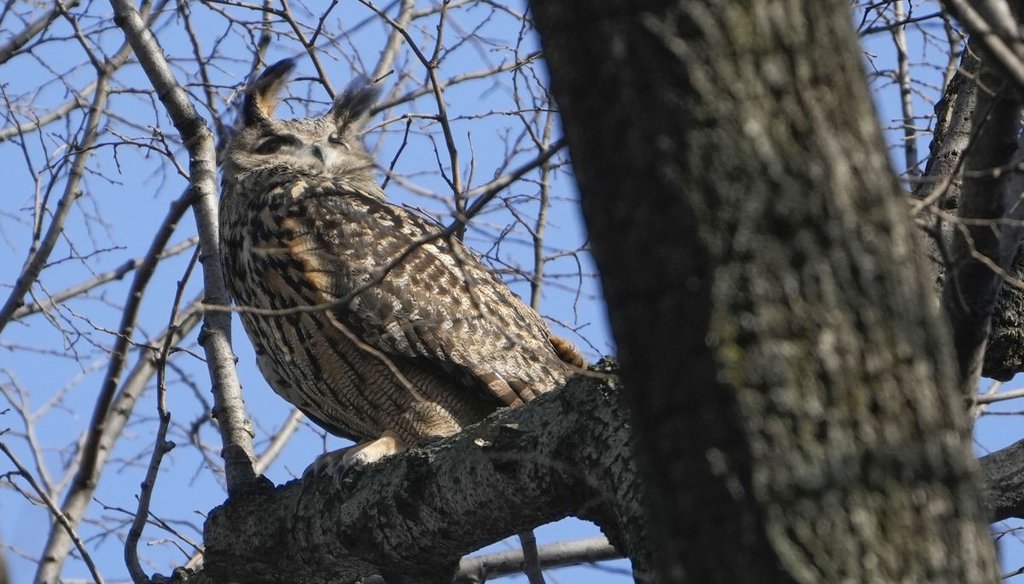

Our only agenda is to publish the truth so you can be an informed participant in democracy.
We need your help.


A Eurasian eagle-owl named Flaco, who escaped from the Central Park Zoo, shown in a tree in New York's Central Park about a year before his February 2024 death. (AP)
Estimating the number of bird deaths is difficult, and even the best academic attempts have described broad ranges. However, published data supports both Holyman-Sigal’s number for New York City and his number for the U.S. as a whole.
The New York City number is a decade old, but experts say that more buildings in the city means that the old estimate could be low.
Our mission: Help you be an informed participant in democracy. Learn more.
As New York state legislators weigh tougher laws on building design and outdoor lighting, one state senator cited the harm to birds caused by building collisions in New York City and beyond.
In February, Flaco, a male Eurasian eagle-owl, died from crashing into a Manhattan building. Flaco had attracted local and national attention after escaping from the Central Park Zoo and surviving in the wild despite having been raised in captivity.
State Sen. Brad Holyman-Sigal, D-Manhattan, supports two bills that would protect birds from collisions: S.7663, which would regulate outdoor night lighting, and S.7098, which would require certain state-owned buildings to be modified to reduce bird deaths. Committees are considering the bills.
On Feb. 26, days after Flaco’s death become public, Holyman-Sigal said in a statement that "nearly a quarter million birds in New York City, and more than one billion across the country, die each year from collisions with buildings."
We found that published research supports this estimate of birth deaths. However, experts cautioned that this is a tricky statistic to calculate, and the data that Holyman-Sigal’s office cited to support his statement is about a decade old.
Holyman-Sigal’s numbers for New York City stem from data collected by NYC Audubon, an environmental group devoted to protecting birds and bird habitats.
Dustin Partridge, the group’s director of conservation and science, said that collision monitoring efforts reported between 90,000 and 243,000 birds dying from collisions every year in New York City.
Holyman-Sigal’s figure resides on the upper end of that range, and it was published in 2014 based on 2013 data, making it just more than a decade old.
However, Partridge said that this range could be low, as the city’s building count has expanded during the past decade. Today, New York City has more glass than it did in 2013, Partridge said, potentially lowering bird survival rates.
As for the national figure, that’s well within the range of a recent Wilson Journal of Ornithology paper co-authored by Daniel Klem Jr., a professor of biology at Muhlenberg College.
That article said that nationally, 621 million to 2 billion birds die annually in the U.S. from collisions, with potentially billions more dying similarly worldwide. According to that paper, half of bird-window collisions leave no evidence of a strike, potentially producing artificially lower numbers for deadly collisions.
Scott Loss, a professor of global change ecology and management at Oklahoma State University, said such estimates are broadly in line with those in a 2014 journal article he helped write.
Still, Joel Best, a University of Delaware sociology professor who has written about bird strike estimation, cautioned against trusting estimates of a topic that is so hard to track. Humans can't monitor all birds, he said. Although a large number of bird collisions surely occur, he added, bird welfare advocates have an incentive "to exaggerate the size of their social problems," Best said.
Holyman-Sigal said, "Nearly a quarter million birds in New York City, and more than one billion across the country, die each year from collisions with buildings."
Estimating the number of bird deaths is difficult, and even the best academic attempts have described broad ranges.
However, published data supports both Holyman-Sigal’s number for New York City and his number for the U.S. as a whole. The New York City number is a decade old, but experts say that more buildings and glass mean that the old estimate could be low.
We rate the statement Mostly True.
New York state Senate, "Legislators, Advocates Rename Statewide Bird Safe Buildings Act the "FLACO Act," Feb. 26, 2024
New York state Senate, S.7663 and S.7098, accessed March 15, 2024
The Wilson Journal of Ornithology, Evidence, consequences, and angle of strike of bird–window collisions, accessed March 15, 2024
Oxford Academic, Bird–building collisions in the United States: Estimates of annual mortality and species vulnerability, accessed March 15, 2024
Email Interview with Dustin Partridge, NYC Audubon Director of Conservation and Science, March 8, 2024
Email Interview with Scott Loss, professor of global change ecology and management at Oklahoma State University, March 8, 2024
Email Interview with Daniel Klem Jr., professor of biology at Muhlenberg College, March 7, 2024
Email interview with Joel Best, sociology professor at the University of Delaware, March 12, 2024
Statement to PolitiFact from Brad Holyman-Sigal’s office, March 7, 2024
In a world of wild talk and fake news, help us stand up for the facts.
